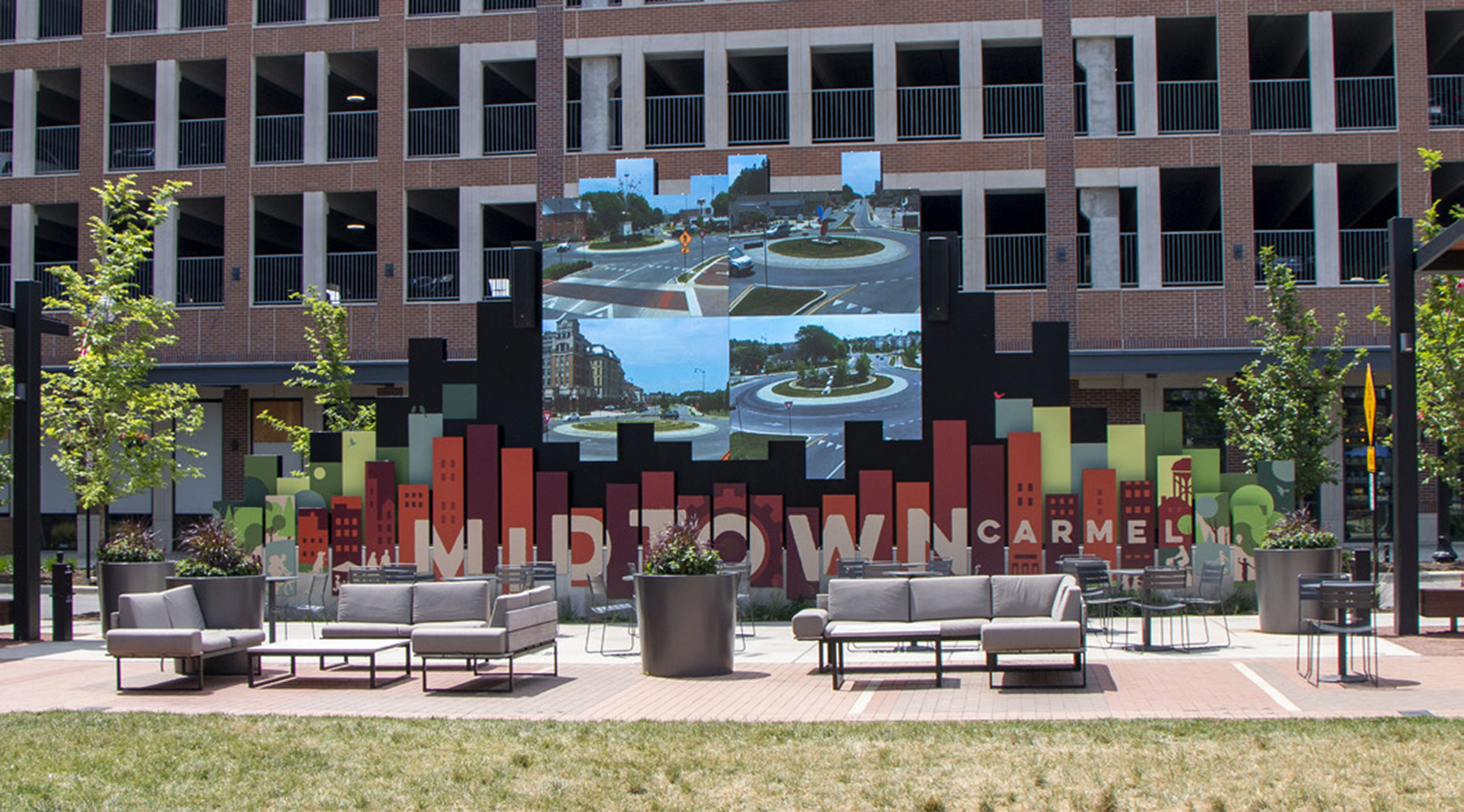Outdoor Digital Signage Makes Social Distancing Entertaining
Whether for company events or public gatherings, creative thinking has been key, and digital signage plays a key role.

“Keep it outside” has been the mantra during the pandemic. Whether company events or public gatherings, creative thinking has been key, and digital signage is playing an important part in helping to keep people safe and socially distanced.
Art and Messaging
Midtown Plaza is a new, vibrant revitalization of Carmel, IN’s old industrial area. It is located in the heart of a thriving center of entertainment, urban-style living and commerce. Midtown brings its own unique urban atmosphere, distinct from its adjacent districts, serving as a connection between the Arts and Design District and City Center.
Serving as a piece of art, an avenue for communication, and a source of entertainment, a large LED video wall sits in the center of the Midtown Plaza. LED display company Neoti worked with an architect and audio visual integrator CCS to supply a custom solution.
Neoti’s product approach is to gather the “4 D's”: distance, domain, design, and details. The viewing distance would range from 30 feet to 200 feet, depending on how the screen was being used. Neoti suggested a 6mm pixel pitch to provide the best experience for all applications. The second D is “domain,” or environment. This use case required a rugged panel that could withstand the harsh Midwest winters. The next element Neoti studied was the design. Design renderings conveyed a stair-stepped edge on both the top and bottom of the display, prompting custom-sized modules to accomplish the goal. The final D culminates in the details, such as the content (communication, art, entertainment), structure, and media controller.
Flex Space
At a new BASF location in Research Triangle Park, NC, a large pavilion was built as a flex space for corporate events, gatherings, presentations, and formal meetings.
“We needed a system that offered high image visibility and that would not be affected by the elements, including high temperature, humidity, and pollen,” said Jeffrey Coger, BASF facilities engineer.
BASF engaged audiovisual systems integrator AVCON. “They’re objective was to create an environment that would appeal to their workforce—more companies today are investing in experimental facilities as a way to differentiate themselves and compete for talent,” said Chuck Jones, senior project developer, AVCON. “We began exploring LED technology, and specifically, a solution that was fully outdoor-rated with low pixel pitch and ultra-high brightness.”
A daily selection of features, industry news, and analysis for tech managers. Sign up below.
“The Planar VVR Series LED video wall meets all of the client’s needs: it is bright, high resolution, weatherproof, and blends with the pavilion from an aesthetic standpoint,” Jones said. “They now have a display technology that gives the pavilion the impact they were looking for. It looks just phenomenal.”

In Their Own Words
Neoti
Neoti provides a variety of direct-view LED displays that have remained relevant during the pandemic. Large video displays in houses of worship, retail signage, drive-in theaters, and outdoor, high-bright displays for drive-through restaurants.
Possibly the most relevant display type during the pandemic has been the outdoor display for restaurants. Many restaurants were not prepared to provide a socially distant and touchless experience. Now, many restaurants are adding drive-through or curbside service. Large, daylight-viewable displays are instrumental in the efficiency of a drive-up or drive-through experience. Restaurateurs now see the importance of bright, weatherproof displays—especially in areas exposed to direct sun and rain. Many products in the market identify themselves as “outdoor” or “high bright,” but verifying specifications will help.

Most companies recommend that a display have a minimum of 2,500 nits and be IP56 certified. This will assure viewability during the peak brightness of the day and protection against dust and water. However, Neoti’s high-resolution LED displays offer unlimited sizes with no bezels, brightness levels over 3,000 to 4,000 nits, and IP ratings as high as IP65, therefore providing a larger display that lasts longer. As the display ages, brightness will diminish. So, for example, if the display starts at 3,000 nits, it will still be viewable at nearly half its brightness—especially when protected at IP65.
Drive-up and drive-through restaurants with Neoti high-bright outdoor displays will provide a great way to communicate with customers, as well as a socially distant and touchless dining experience for years to come.
Panasonic
From restaurants, to museums, to theme parks, each business and venue planning to reopen will benefit from deploying solutions that assist in a smooth transition from traditional procedures to newly updated processes. To ensure the health and safety of employees and customers, businesses and venues should look to incorporate new and existing solutions that help everyone clearly understand what safety procedures are in place—this is where digital signage technology is key.

In light of changing health and safety standards, digital signage solutions help businesses emphasize the safety protocols they put into place, encouraging employees and customers to follow them, and ultimately, helping the businesses stay open. As the technology develops, we will see new use cases that help businesses not only connect and engage with customers, but also create technology-enhanced experiences. Integrating software like facial recognition may be particularly useful today when it comes to identifying whether a patron wears a face mask, but in the future, this technology could lead to other positive experiences like identifying a frequent shopper and helping her find her way to her favorite section of a store. Ultimately, digital signage technology can help keep both the end user and the business that deploys it more connected and informed.
>> More on Digital Signage
- Privacy and Digital Signage
- Assembling the Digital Signage Puzzle
- Digital Signage Expo Returns for 2022
- Rise Vision Makes Digital Signage Easier and More Affordable With Support for New Media Players
- 22Miles Launches New Line of Ready-Built Digital Signage & Wayfinding Software Bundles
Planar
This year, the pandemic has dramatically changed in-person gatherings and pushed more people outdoors. What has remained consistent is an organization’s need to advertise, relay information, and engage target demographics. Higher resolutions are one way to bring visual experiences to life for companies and end users alike, and thanks to current technology advancements, we find that more customers are looking to achieve this outside—even in direct sunlight.
This is why we recently introduced the Planar HRO Series high-resolution outdoor LED video walls, which offers our customers a high-brightness, fine-pixel-pitch LED offering built for close-up daylight video viewing. Planar HRO Series features 3,500-nit brightness, an aspect ratio of 16:9, and some of the finest pixel pitches available for outdoor LED displays—1.5 millimeters and 1.9 millimeters. Plus, Planar HRO Series LED Displays are built to endure the weather without negatively impacting the viewing experience.

We also released the Planar FX Series in May, providing customers with a solution that brings to high-ambient light environments the same level of close-viewing image detail and resolution historically reserved for lower-light, private spaces. The new line of fine-pitch LED video wall displays is available in a range of pixel pitches for indoor and outdoor applications.
The industry will continue to turn to video wall solutions that allow for close viewing in bright, sun-lit public environments, even after the pandemic. We’re proud to offer our customers product lines uniquely suited to these applications.
Sharp
Since the start of the pandemic, collaboration tools have become more important in our communication with one another—whether that’s remote or in-person. The Windows collaboration display from Sharp has emerged as one such essential solution for enabling more effective collaboration in our new normal—especially in hybrid office settings with some participants in-person and others joining virtually.

The 4K Ultra HD 70-inch Class interactive display comes equipped with a built-in microphone, 4K camera for video conferencing, and IoT sensor hub for the highest-quality audio and video. It is also Skype for Business-certified and equipped with Microsoft 365 and Microsoft Teams. Its built-in sensors can connect to the Microsoft Azure Digital Twins IoT platform and other commercially available cloud services, such as Sharp Synappx WorkSpaces—a SaaS solution that uses data on meeting room conditions taken from the display’s IoT Sensor hub to provide actionable analytics for the modern workplace. This provides enhanced collaboration no matter where you are.
Solutions like the Windows collaboration display have become increasingly necessary as we collectively fluctuate between working remotely and in an office space. It’s important to have tools that work effectively in either environment, so work and collaboration can continue uninterrupted in a safer space. While this is an issue that was brought to the forefront by the pandemic, we anticipate that there will be continued demand for hybrid solutions moving forward.
ViewSonic
With Zoom meetings, hybrid learning, and other non-face-to-face methods being used to communicate, people are being more creative in finding ways to connect and remain productive during this pandemic.
ViewSonic developed a variety of display solutions that allow people to view and share content from a safe distance. This includes the LD-series of displays, which are direct-view LED, all-in-one displays that can be used to deliver messaging and digital signage messaging.

We see that larger-screen displays are being used for meetings or in classrooms; one user is on site with the display, while other participants are brought in via webcam. The displays are large enough that each person has their own “square” without bezels cutting through faces, and ensuring that everyone can be seen and is able to share. The LD135 is larger than four 67-inch LCD displays, while the LD163 is larger than four 81-inch LCD displays combined.
The ViewSonic LD-series comes in both 163- and 135-inch sizes, and includes software that allows for screen sharing, content mirroring, and a 4-in-1 split-screen function that allows up to four presenters. Features include native 1080p resolution, 120-percent Rec.709 color gamut, and an Android 8.0 operating system.
These LD-series displays are easy to install—two people, two hours—and come with built-in software for sharing content. The large size and crisp image quality ensure that messages and faces are vivid and clear.

Cindy Davis is the brand and content director of AV Technology (AVT). She was a critical member of the AVT editorial team when the title won the “Best Media Brand” laurel in the 2018 SIIA Jesse H. Neal Awards. Davis moderates several monthly AV/IT roundtables and enjoys facilitating and engaging in deeper conversations about the complex topics shaping the ever-evolving AV/IT industry. She explores the ethos of collaboration, hybrid workplaces, experiential spaces, and artificial intelligence to share with readers. Previously, she developed the TechDecisions brand of content sites for EH Publishing, named one of the “10 Great Business Media Websites” by B2B Media Business magazine. For more than 25 years, Davis has developed and delivered multiplatform content for AV/IT B2B and consumer electronics B2C publications, associations, and companies. A lifelong New Englander, Davis makes time for coastal hikes with her husband, Gary, and their Vizsla rescue, Dixie, sailing on one of Gloucester’s great schooners and sampling local IPAs. Connect with her on LinkedIn.
